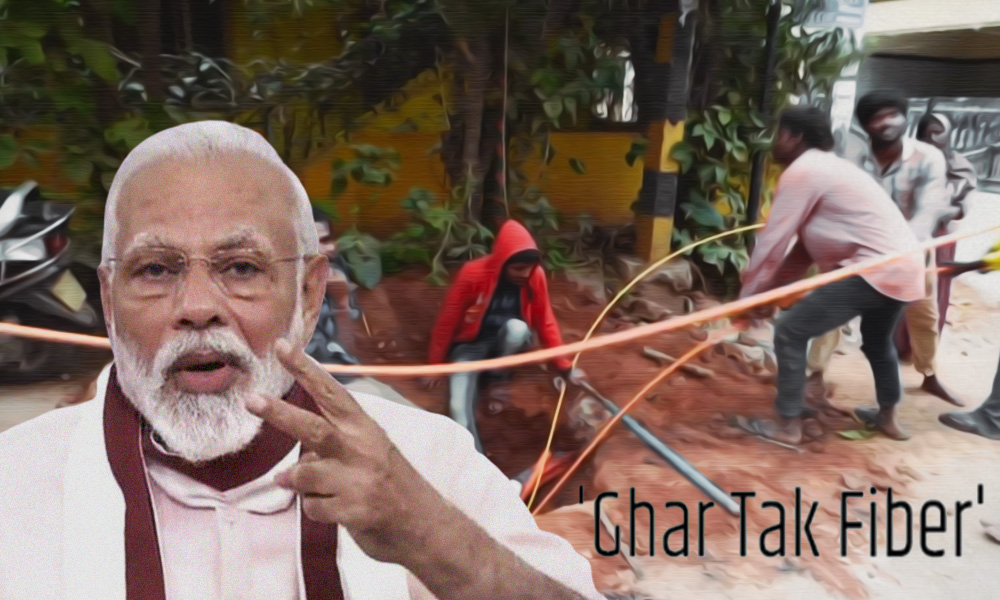
Credits: Facebook
'Ghar Tak Fibre': Slow Progress In Scheme To Connect Bihar Villages
Writer: Devyani Madaik
A media enthusiast, Devyani believes in learning on the job and there is nothing off limits when it comes to work. Writing is her passion and she is always ready for a debate as well.
Bihar, 19 Oct 2020 10:12 AM GMT
Editor : Shubhendu Deshmukh |
Shubhendu, the quint essential news junky, the man who loves science and politics in equal measure and offers the complete contrast to it by being a fan of urdu poetry as well.
Creatives : Abhishek M
" An engineer by profession, Abhishek is the creative producer of the team, graphic designing is his passion and travelling his get away. In more ways than one, he makes the content visually appealing."
Under the scheme, the state has to provide at least five fibre-to-the-home (FTTH) connections per village, while there should also be at least one WiFi hotspot per village.
The government's 'Ghar Tak Fibre' scheme, which aims to connect villages across India with high-speed internet is off to a slow start in Bihar, unable to complete the monthly average target. Bihar is the first state that aims to connect all its 45,945 villages by March 31, the government data obtained by The Indian Express showed.
The state had to provide connectivity to an average of 257 villages daily, or a monthly average of over 7,500 villages. However, nearly a month after the scheme was inaugurated, optical fibre cable has been laid only in 4,347 villages up till October 14, or at the rate of 181 villages per day, reported the media.
"Our present capacity is laying down between 80,000-1,00,000 km of optical fibre per year. To connect all the villages by March 31, 2021, we will need to lay down at least 2,00,000-2,25,000 km of optical fibre, which is a tough task," an official from the Department of Telecommunications (DoT) told the media.
While inaugurating the scheme on September 21, Prime Minister Narendra Modi assured that 45,945 Bihar villages would be connected through the high-speed optical fibre.
Under the scheme, the state has to provide at least five fibre-to-the-home (FTTH) connections per village, while there should also be at least one WiFi hotspot per village.
According to the report, the tender for providing connections and 'lighting' up these villages has not been floated so far and is likely to be floated only in the first week of November.
Of the 8,745 GPs in Bihar, 5,889 were connected to the state's main internet grid under BharatNet phase one, while the remaining 2,856 were connected under phase two. However, of all the GPs connected under phase one, about 60 per cent were not operational up till October 15, and the status of the rest was unclear.
Jehanabad, Darbhanga, Purnia, Kishanganj, Vaishali, Araria, Saran and Jamuni were some of the GPs connected to the internet under BharatNet phase one, which is less than 25 per cent, says the report.
The main problems behind such slow pace growth are the lack of power and related equipment failure, equipment theft, and faulty or lossy leased fibre.
"There are three main problems. One is that the lossy, old cables that were laid under phase one have to be replaced. So far, that work has been done in about 4,500-gram panchayats connected under phase one. Then the problem of right-of-way in laying cables from panchayats or blocks to individual villages. The third is power equipment failure and its theft," the official added.
Lack of users in the areas has also resulted in minimal follow-ups on repair and maintenance work.
Also Read: India Fourth Most Powerful Country In Asia, China Closing In As Lead: Asia Power Index 2020
 All section
All section














